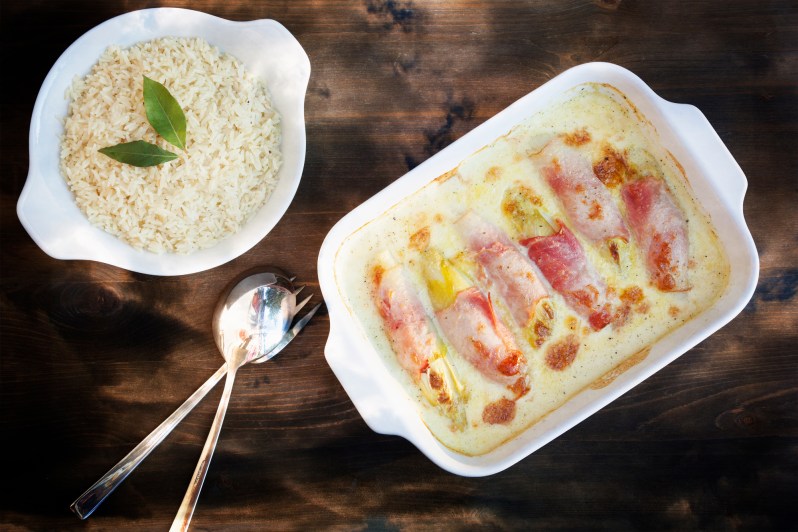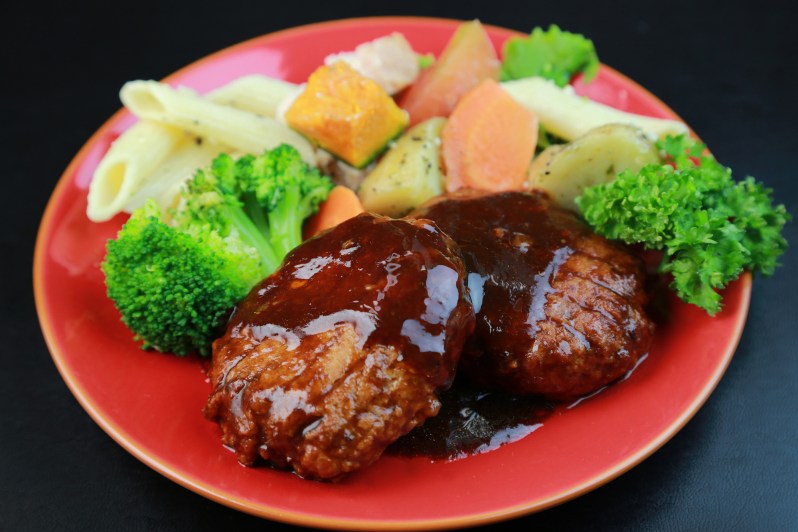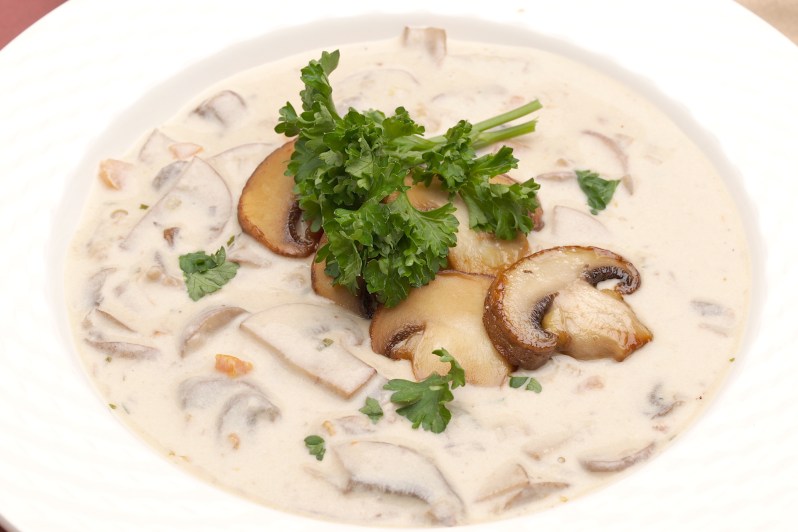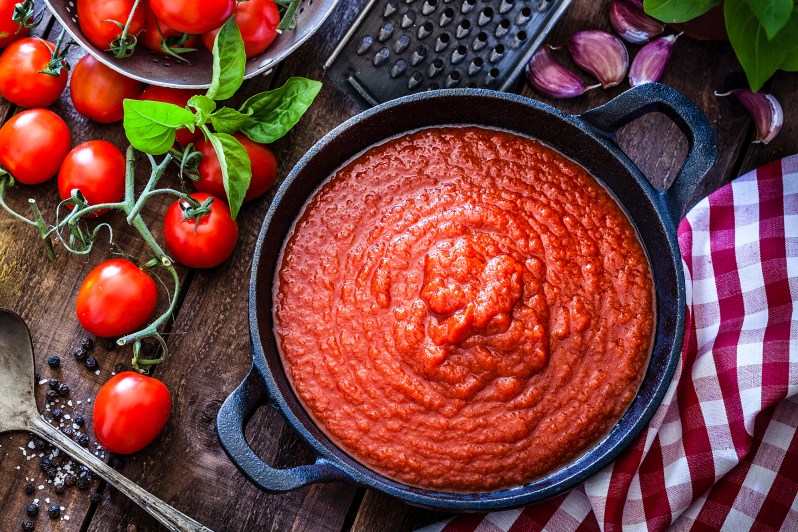The five sauces included in the “mother sauce” canon of classic French cooking are culinary-school staples for numerous reasons, but perhaps the most substantial argument for studying these sauces involves their potential for customization. Clever chefs have free rein to reimagine and revamp the traditional mother sauces, incorporating different spices and flavor agents to create unique sauce alternatives. We asked a group of pro chefs for their favorite mother sauce twists, and they offered up these 8 spins on sauces béchamel, hollandaise, espagnole, velouté, and tomate.
Béchamel

Add eggs for a firmer texture.
Made by mixing milk into a flour-and-butter roux and flavoring with herbs and aromatics, béchamel traditionally features a fairly loose texture. However, according to chef and instructor Amy Riolo of Casa Italiana School in Washington, D.C., “classic Greek recipes such as pastitsio often incorporate eggs into a béchamel, which makes it firmer and richer for topping savory baked dishes.”
Use Comté cheese to bolster the béchamel and make it an ideal filling for savory crepes.
One of the most popular mother sauce offshoots comes in the form of Mornay sauce, a variation on béchamel that includes cheese. Mornay sauce usually utilizes Swiss Gruyère cheese or a similar type of hard, easy-to-melt, and salty cheese (white Cheddar, for example). Jeb Aldrich of Tiny Lou’s in Atlanta personally likes to use Comté cheese in his Mornay; this French cousin of Gruyère is known for its rich, buttery flavor, and Aldrich thinks that it makes an ideal match for his signature crepes. At Tiny Lou’s, “thin crepes are topped with popped sorghum and a carrot vinaigrette and filled with a béchamel–Comté sauce, fusing these traditional French staples with Southern elements and a surprisingly light taste.”
Hollandaise

Use bacon fat and brown butter to turn hollandaise into an unexpectedly delicious seafood sauce.
Arguably, hollandaise sauce’s greatest claim to fame is its use in the brunch staple known as Eggs Benedict. Therefore, it’s no surprise that bacon fat and hollandaise work in perfect cooperation together. Slightly more surprising? The fact that bacon fat, hollandaise, and brown butter can combine to create a beautiful sauce for seafood. Executive chef Jakob Esko of The Ritz-Carlton Half Moon Bay in California swears by this variation, telling us that “hollandaise sauce is a great basic sauce that is perfectly suited to add flavors and ingredients to better match the dish. Adding a small bit of bacon fat makes it really nice. Using brown butter (or “beurre noisette”) is excellent, also in combination with the bacon fat. It’s perfect on oysters.”
The addition of caramelized tomato paste and white soy sauce gives hollandaise an extra dose of umami.
Hollandaise’s primary flavor profile focuses on butter and acid, but if you want to add some complex savory notes, then chef/owner Christopher Kearse of Forsythia in Philadelphia has a suggestion for you: “We make a sauce called Chiron sauce. Classically, it’s hollandaise with tomato. We add white soy sauce and caramelized tomato paste, [which we] slow roast with butter in a non-stick pan for 2 hours, for a little twist on a classic. We keep it in an iSi canister [a whipping canister] for better texture.”
Espagnole

Demi-glace, the most popular sauce inspired by sauce espagnole, can become a great warm vinaigrette.
Espagnole, a mother sauce made with a roux and beef stock, is often used as a starting point for demi-glace, a rich and glossy sauce that contains equal parts espagnole and brown stock made from beef or veal. It’s one of the most widely used mother sauce offshoots, and chef and “mustard sommelier” Brandon Collins of Maille tells us that “I like to use demi-glace as a binding agent in warm vinaigrettes. I’ll then use this as a sauce for scallops or red meat. A favorite pairing would be scallops with Dijon mustard and black pepper vinaigrette [with demi-glace], grilled ramps, salt-boiled potatoes, piquillo peppers, and [scallop] adductor mayo.”
Velouté

“Venetian sauce” is a twist on velouté that works especially well with seafood.
Like Mornay sauce and demi-glace, Venetian sauce falls into the category of classic mother sauce twists, but it tends to fly a bit under the radar. Executive chef Andrew Asken of Dusek’s Board & Beer in Chicago describes this velouté derivative like so: “Venetian sauce [is] a riff on velouté, [and it] is one of the lesser-known sauces out there. Traditionally, the sauce is created by making a blond roux and incorporating fumet (fish stock) into it, then seasoning it with equal parts tarragon vinegar and dry white wine that has been reduced by half.”
To further customize his Venetian sauce, Asken likes to “first melt butter, then cook lardons of prosciutto, bacon, country ham or whatever cured pork I have on hand, then add flour to the butter and pork to create a roux. I [then] add fumet and cook until thickened, then season the sauce with the tarragon vinegar and white wine reduction to add brightness and acidity. I finish the sauce with salt and black pepper to taste. After the roux is cooked and the sauce no longer has a flour-y taste to it, I strain out the lardons. The pork adds a nice fermented and salty characteristic to the sauce, which pairs really well with seafood. I’ll serve this sauce over salmon with roasted vegetables and grains that have lots of spice. The salmon can hold up to this type of sauce without being overpowered, and the acid from the vinegar and wine reduction cuts through the fattiness of the fish while complementing the vegetables.”
Pureed sunchokes bring a sweetness and a smoothness to a roux-free velouté.
Velouté’s naturally savory flavor can benefit from some contrast, and culinary director Carlos Cruz of 16” on Center hospitality collective in Chicago says that “for a twist on velouté, I enjoy pureeing roasted sunchokes into the sauce. This gives the velouté a touch of sweetness that pairs well with crab or any seafood.” Adding sunchokes to his velouté also allows Cruz to make the sauce without the need for a roux, resulting in a gluten-free velouté with a “nice consistency.”
Tomate

The classic French tomato sauce can serve as a base for tikka masala.
Tomato sauce figures majorly into numerous international cuisines, and the version included in the “mother sauce” list can be thoroughly transformed through the addition of spices and aromatics. For instance, executive chef and owner Anish Nair of Jai Ho in Atlanta “uses tomato sauce as the base for one of Jai Ho’s all-time guest favorites: Tikka Masala. To provide additional flavor to the sauce[I] add cream, yogurt and herbs, including fenugreek leaves, ginger, coriander, bay leaf, cilantro, and turmeric. [I swap] plum tomatoes for the regular tomatoes usually found in tomato sauce and use honey to balance the sweetness with the sharpness of the tomatoes.”



